My
Adventures With m0n0wall Software
As anyone who knows me
will tell you,
I have no shortage of computer equipment. It comes from all kinds of
places...curbside discount, people who have upgraded, mysterious
"gifts" that end up on my porch or lawn, or in ways that are unique but
have no doubt been forgotten about.
Some end up being cleaned up, repaired and donated to those who need
them more badly than I do. Some become loaners (these are for people to
use when I'm working on their main computer). Others get recycled or
parted out. Ones that don't work and cannot be repaired or that are made of dried and pressed
garbage formed into the shape of a computer may get run over after any
remotely good parts are harvested. Still others sit and wait their turn for a suitable project to cross my mind.
Then there are some that don't really fit into the above categories...the ones
that still work fine yet are so utterly outmoded that you can't think
of anything else to do with them. These are the computers that qualify
as "vintage" yet have little to no value or uniqueness. And after you
realize that you only need so many older systems to run any old
programs or games, there just isn't anything left for them to do.
I hate to throw anything that might be useful away. The mountains of
"stuff' around here will attest to that. There are two reasons for
this, one you just read and the other, which dictates that any time I do
throw something out, I will immediately come up with the perfect thing
to use it for after it's gone. My life is a comedy, and I've mostly
come to accept this sort of thing as inevitable.
This page tells the story of one of "those" computers. Allow me to
present to you... (cue drum roll FX, please)
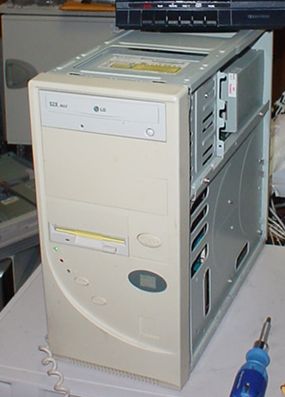
...this. Here we have a generic looking PC that a friend gave to me,
along with another PC with a slightly newer motherboard and monstrously
big case. Some assorted "parts" also came my way. Most of the parts
have come in handy for some purpose or another, and the other computer
is presently being subjected to invented swear words while I work at
beating it into submission as a FreeNAS system. Provided I don't throw
it right out the window in the near future, that other system will be
used to store copies of the data on my first FreeNAS system. Rsync will
make these copies and the system will be located offsite. More on that
later, on a separate page (of course). Although, if you've decided
you'd rather read about that project, you can find that
particular...uhm..."epic" right here. (Don't say I didn't warn you about the length.)
This PC is built around an ASUS SP97-V motherboard. For those of you
following along at home, the SP97-V board is an interesting mix of the
new and old. It's a baby-AT form-factor with support for the good old
AT type power connections as well as the then up-and-coming ATX power
connector. It uses socket 7 processors and does not have support for
the later "Super 7" processors. (Intel's own socket 7 processors never
went faster than 266MHz. AMD and others pushed things much further, up
to at least 550MHz before the party was finally over. Of course, you
couldn't just drop one of those third party processors into most socket
7 systems, you had to have a board that would support it and not
Majorly Freak Out at the sight of a then-insanely-fast CPU.)
This ASUS motherboard takes old-fashioned 72-pin
SIMMs. The problem with SIMMs is that back in the days of computing
when the world was still in black and white, 4, 8, 16 and 32MB of RAM
was the
in thing. Some lucky people had 64 megabytes of RAM. Few people had any
need for much more
memory
than that, and when they finally did upgrade, the DIMM was the big
thing to appear with their new motherboard, processor or even PC. It's
not hard
to find motherboards that have both types of memory sockets to guard
against obsolence for just a little while longer. This board does not,
and today, in the name of progress, most software really needs more
than the
48MB of installed RAM this system came with. 
The software I planned to use wanted 64MB of installed RAM at a
minimum.
Fortunately, some years ago, I knew a guy by the name of Christopher
Hutchins who was sitting on a veritable mountain of SIMMs. (Those were
his own words.) I can tell you're surprised. Funny thing is, I came to
know him in the better days of alt.trucks.chevy when we spent time
talking about various and sundry rustbuckets that we'd seen or been
working on.
On December 20th, 2004 or so, he sold me two bags worth of 32 megabyte
72-pin EDO SIMMS, tested and guaranteed working for a downright cheap
$2 per module. (Try to find it at that price now!) I went through one
bag pretty quickly while refurbishing some HP Vectra VA and VL
computers. The other one remained unopened until, in 2009, I built my
first FreeNAS system and needed more RAM to get it off the ground. I
don't know where Mr. Hutchins is today but I'm sure he'd be impressed
that it's taken me this long to get through the modules. I am also
impressed, because this means two things: my old computer collecting
habit isn't totally
out of control and I probably won't ever run out of these modules for
some time.
Even better, the ASUS SP97-V motherboard supports EDO SIMMs. As proof
that my organization system works when people don't perceive it as
everything thrown everywhere and in need of "helpful" straightening up, I found
the bag of modules right away.
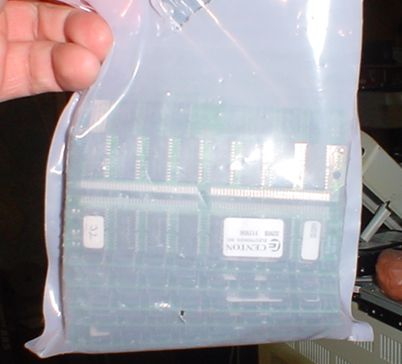
What's more, I even managed to find an old Tandy AT keyboard with the
5-pin "DIN"
connector required by this ASUS motherboard. (Yes, it's really that
old. However, it does have a PS/2 mouse riser.)
When one has this much good luck, he just can't help but wonder when
good old Murphy's law is going to nail
him.
You're probably saying "OK, that's nice. So what were you
going to DO with that computer?" at this point.
Well...
I don't know how it was that I became aware
of it at first, but I wanted to try out this operating system/software
package known as m0n0wall (from now on, I'll call it monowall, just
because I don't feel like typing the 0s). The already mentioned FreeNAS
is based on monowall, but I am pretty sure I knew of it before then.
Every time I say "monowall" I cannot help but think of the Simpson's
episode where the monorail came
to Springfield. Quit looking at me funny. I doubt that I'm the
only person to have a drawn a parallel between the two words, despite
their very different meanings. Funny thing is, as I'm writing this
passage and getting ready to add a link to a description of that very
episode, another Simpson's episode has been selected as the Wikipedia article of the day. Which is really a rather amazing coicincidence...
Monowall requires a 486 or better processor and very little memory in
order to work. In other words, it can run on computers that would make
this one look like a puppy. What monowall allows you to do is build a very capable firewall
with which you may regulate the flow of TCP/IP communications traffic
to and from the Internet or at least two different networks. You can
always buy little boxes that do this just as soon as you plug them in,
but if you're cheap and/or like free stuff, monowall can do the same thing
with two network cards and a PC.
In other words, it's just the thing for those who drive their riding lawn mower or
tractor to the grocery store because it gets you from point A to point
B without the expense of a car! (Sorry. That's a sarcastic remark.)
In all seriousness, even an old computer like this one will frequently
have a lot more memory and a more powerful, general purpose CPU that is
much more flexible in what it can do as compared to the purpose built
ultra low power CPUs found in most routers. It does not take a lot of
computing muscle to
apply rules that define who may and may not communicate with whom
between two networks, although the needed CPU speed will usually
increase as the rate of communication goes up.
Many "little routers" and
their built in firewalls are quite good,
especially those that can run the
phenomenal DD-WRT firmware, which I absolutely love. They take up a
lot less space than a computer running monowall would, but few of them
can route at wire speed on both of their network interfaces.
That's normally fine--you don't always need a lot of processing power to route traffic, as most people's Internet
connections have actual data rates much slower than what a private
local area network will stand. A lot of the time, you'll get anywhere
from a 1 to 12 megabit data rate to the Internet, where a private local
area network inside your home can easily communicate at 100 megabits
or more. It's when you have lots of clients, lots of firewall rules or
more than just a private and public network that you might need more.
An old PC can usually do the job nicely and it costs a lot less than
heavy-duty networking gear would.
That's not all you can do. Monowall can act as a
DHCP server to easily
pass out IP addresses to your computers so that they can automatically
get a network connection the moment you plug in to the network, and you
can even use it in conjunction with
another router/firewall device if you want to make a "private" network
of computers that are for some reason isolated from the other ones. It
can be used to separate invidual computer networks from one another,
while imposing an access control policy to regulate the flow of data
between the networks. It can also create virtual LANs, something that
I've never done, tried to do or even know very much about.
That concept of separation between networks is actually what I wanted
to do with this system. As things are now, I do freelance computer
consulting, which means that every now and then I have to deal with a
computer that is, for want of a better way to put it, "icky", meaning
that they are infested with viruses or malware of some kind.
As some forms of ick (viruses, spyware, etc.) are vicious, they'll
fling their "ick" onto other clean computers if those computers are on
the same private network as the infested one. I've typically prevented
this by manually moving cleanup tools to the infested computer disk
after hooking it up to a clean computer as a non-boot drive. I've also
done scans from the clean computer before and after fixing a mess to be
sure it's
all gone.
Usually, though, I have to test the cleaned machine to be sure it works
properly. And that's where the desire to have a dedicated network where
these computers can be put comes in. In the case that there is
still something wrong, you won't end up spraying it all over your clean
systems. Up until now, I've found ways around this, usually by running
a machine back to the customer's house temporarily to test it. That's
really not the best way, and it looks unprofessional. Fortunately, it
only happens that way rarely. I've gotten very good at the art of
removing crapware from PCs, even the very persistent stuff.
Other Hardware and Stuff
(I plan to add a link to a page that talks about the Asus motherboard
in greater detail and offers some downloads that those still using such
a board might find helpful. Stay tuned!)
Monowall bases itself on the FreeBSD operating system. Not all hardware
works well outside of a Windows world, so you do want to be sure that
you pick hardware that will operate correctly. Sometimes this is a
guessing game...what works in one system won't work in another. Still,
there is some hardware that just works like it should no matter what. On that list
would be Intel's network adapters. I have boxes of them, all casualties
of the mass exodus of networking hardware from an expansion card to a built in motherboard
feature. Although this machine came with a Linksys LNE100TX adapter in
place, I decided not to even bother with it. The Intel cards work while many
others just don't. I can put the Linksys card into the giant mystery
NIC box and it will come out eventually for use in another project.
Curiously, with no network cards installed, the monowall operating
system detected an "sis" network card. Although even the official
documentation for the chipset says nothing about it, I wonder if the
SiS 5598 on this motherboard has some vestigial network functions that
were under development.
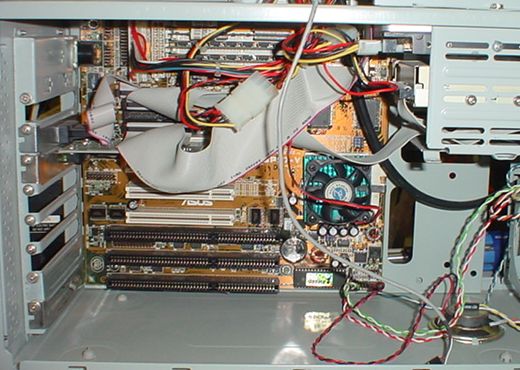
I made some other changes as well. I don't know the provenance
of this computer or even how it began life, but it had a curious mix of
parts in it. A 10GB hard disk and 52X CD-ROM certainly aren't near the
portion of the timeline occupied by this motherboard or even the case. They're also
overkill for this job, so out they went. I put into place an old 2GB
4,500 RPM Seagate Medalist hard disk and a 4X CD-ROM. Given that the
system only uses the hard disk for booting and the CD-ROM is unlikely
to be needed again for some time, there is no need at all to use even
remotely bleeding edge parts for this job.
As this was a desktop computer in a previous life, it had a sound card
alongside a modem. There were also a few port brackets slotted into the
case. Since I don't need them, I disabled all of the ports and removed
the other cards. Video comes from the onboard SiS chipset, so there was
no separate video card, only a riser that is still in the system and
will stay there should I need to have a monitor hooked up for some
reason. The only cards in place now are the two Intel 82558 network
cards.
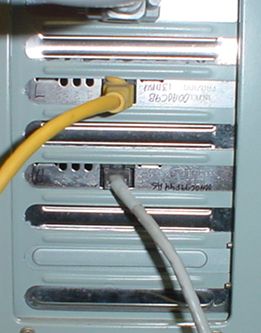
I found some slot blanks to fill in the holes, just because I'm one of
those people who is a little fussy about such things.
Oh, and because I could, I hooked up the dormant front panel speed
display. Remember when computer cases always had these? I do! As the
display elements are only seven-segments, they can't display many
letters. Therefore, the display is intended to read "FW" (for
"firewall") and not the somewhat rude "FUU". I had no choice
but
to split the "W" between the two other positions. It'll do, use your
imagination! Getting the readout to work took some blind
experimentation. At least the nice folks who built this case had the
decency to label the power connector on the display--otherwise
something might have gone "foof" when setting this up.
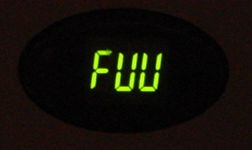
There are other improvements to be made. When checking to see what sort
of processor was on this board, I noticed that there was no heatsink
paste at all between the heatsink and CPU. I added some to allow for
better heat transfer between the heatsink and CPU--not that I'm sure it
was needed.
How Well Does It Work?
I downloaded some files from high bandwidth web sites that I knew could
saturate the bandwidth of my Internet connection. I have a
twelve-megabit-per-second connection speed, and during off-peak hours I
can get pretty close to pulling things down at close to that speed so
long as the computer that's doing the sending can keep up. I saw pretty
steady transfers of 1.2 megabytes per second. As a ten megabit
connection would equal 1.25 megabytes of data transferred at 100%
efficiency, that's not bad performance. You'll never quite make it to
100% productive use of your bandwidth (due to unavoidable factors such
as control traffic and "background stuff". Clearly this computer can
shift data through its mill and between the network cards at a rate
fast enough for most people.
I don't know and haven't tried to find out how close to wire speed it
will come when shoveling packets between the two network interfaces. I
expect that it can probably get pretty close to filling up
a 100 megabit line with the hardware currently in use. For the record,
the processor is a 233MHz Intel Pentium MMX CPU.
Robustness
Of course, your newly configured monowall could perform very well, but
that will not mean anything at all unless it is reliable. I'm pleased
to report that it's very reliable under the short term tests that I
have made. You can even pull the plug on it at any time with no ill
effects whatsoever, as the boot disk is never written to unless you are
configuring the firewall itself. With anything else based on a Unix
operating system, shutting down your computer by pulling the plug is a
good way to win the "my disk is so corrupted that the computer won't
even start"
award. That won't be a problem here.
The Finished Product
Here's everything back together again and running.
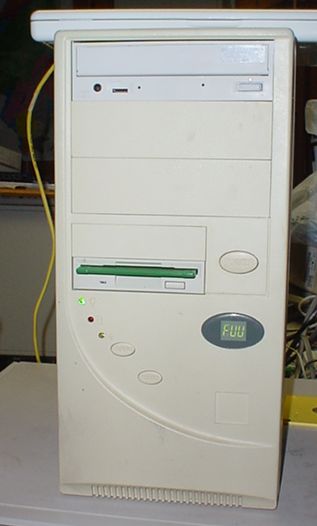
Now all I have to do is find a place to put it and hook up a network
switch so I can plug in other computers when I need to. Then it will
truly be complete.
Go
Back>
Copyright
© 2010 William R.
Walsh. All Rights Reserved. Permission is granted to reproduce this
material or to use any part of it in other creations, so long as the
following terms are met: attribution to this page and its author must
be supplied, no part of this page may be displayed along advertising
content of any sort, no fee may be assessed to provide access to this
information (except as reasonably necessary to cover connection time or
printing supply expenses) and no part of this material may be used in
creations that are illegal, dangerous or derogatory. Created
04/29/2010, updated 04/30/2010. This page is still a work in progress.
Although what is here is believed to be correct, not everything may be
completed. Please check back soon.






